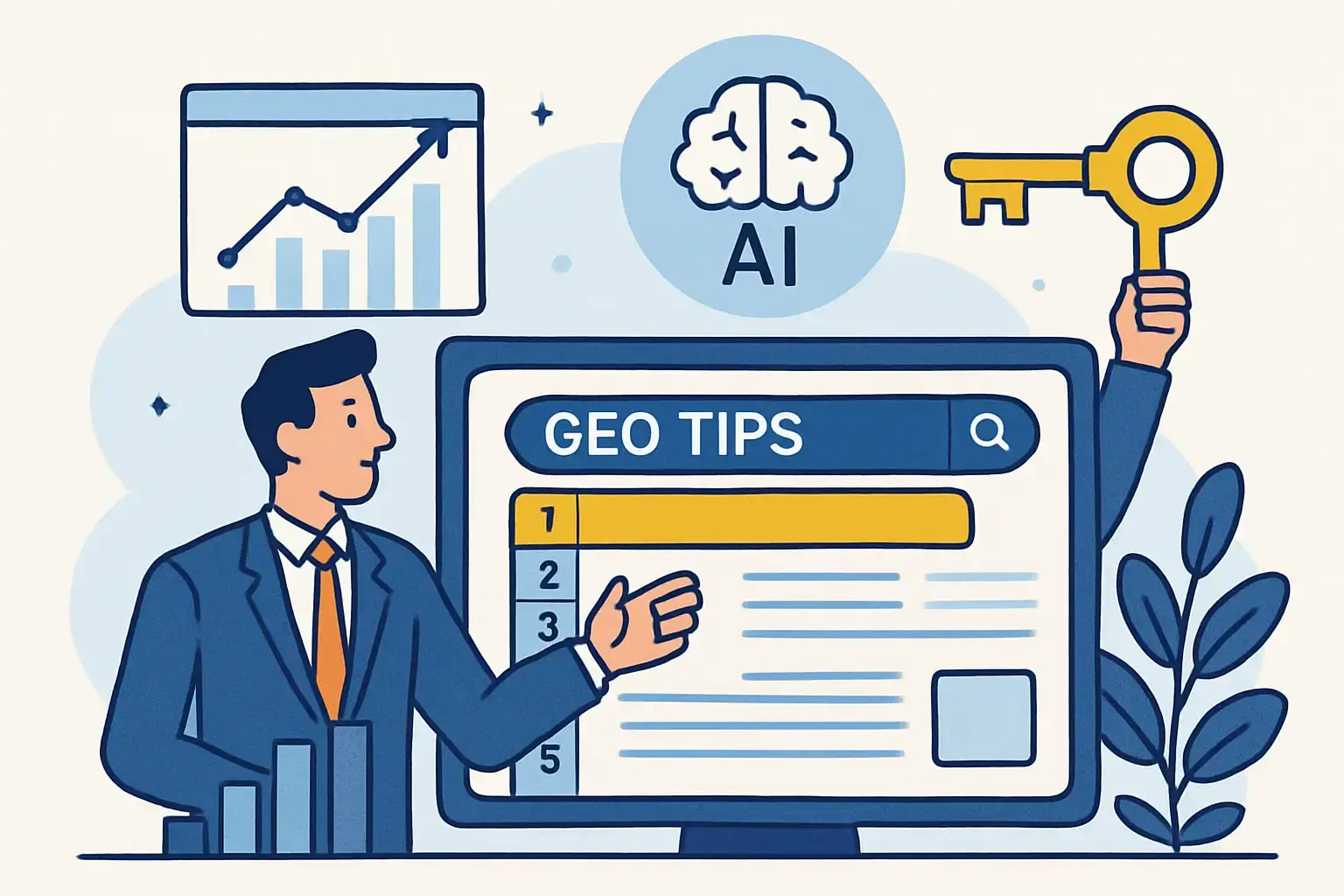How to Rank in AI Search: 5 GEO Tips to Get Cited by Perplexity & ChatGPT

TL;DR — To rank in AI search, follow five GEO pillars: map conversational intent and task paths (not just keywords), go entity-first with architecture and schema, make your content LLM‑citable with evidence and unique data, open the door to AI crawlers and machine readability, and build off‑site reputation with clear E‑E‑A‑T signals and citations. By combining structured data, consistent naming, and internal linking to reinforce a robust entity graph, you’ll create llm citable content that often shows up in AI overviews and ranks in chatGPT, Claude, and perplexity results—delivering practical, step‑by‑step tactics for how to rank in ai search.
For a deep dive, check out this ultimate guide to AI Search optimization in 2025.
Table of Contents
Tip 1: Map Conversational Intent and Task Paths (Not Just Keywords)
If you want your content to get picked up and cited by AI search engines, you need to think beyond keywords. The key is to map out conversational intent and the task paths users follow when they ask questions. Here’s how to do it:
Turn AI Prompts into Intent Clusters and Task Steps
-
Analyze AI-style prompts and queries
Start by gathering common questions and prompts people use around your topic. These often come from AI chat logs, search query reports, or tools that show conversational queries. -
Group prompts by user intent
Sort these into clusters based on what the user really wants:- Informational: Looking for knowledge or how-tos
- Navigational: Trying to find a specific page or resource
- Transactional: Ready to take action, like buying or signing up
-
Break down each cluster into task steps
For each intent cluster, outline the sequential steps your page should cover. For example, if the intent is content optimization for AI search, your task steps might be:- Understand AI ranking signals
- Structure your content for clarity
- Build authority with credible sources
-
Use tools to validate and expand
Combine keyword research with AI query logs to make sure you’re covering all relevant conversational angles. This ensures your page satisfies the full user journey, not just isolated keywords.
“Pages that map out clear task flows and conversational intent get favored by LLMs because they match how people naturally ask questions and expect answers.”
Structure Your Page for Fast AI Extraction
Large Language Models (LLMs) love content that’s easy to scan and understand quickly. Here’s what works best:
- TL;DR summaries: Start with a quick, clear answer at the top. This helps AI and users get the gist immediately.
- Q&A blocks: Use explicit questions followed by concise, direct answers. This format mirrors natural conversations and helps AI pinpoint info fast.
- Step-by-step lists: Numbered or bulleted instructions clarify processes and task flows, making it easier for AI to extract actionable insights.
- Clear headings and subheadings: Use intent-driven titles that signal what each section covers.
- Tables and bullet points: Organize data logically to improve readability and AI parsing.
By structuring your content this way, you’re not just stuffing keywords—you’re creating a roadmap that AI can follow to deliver precise, trustworthy answers.
Mapping conversational intent and task paths is your first step to getting noticed in AI search results. It’s about thinking like the AI and the user at the same time—giving both exactly what they need, clearly and quickly.
Tip 2: Go Entity‑First with Architecture and Schema

To get AI models to recognize and cite your brand or topic, you need to build a clear, rich entity graph on your site. That means using the right schema types and linking strategies so search engines and LLMs understand who you are, what you offer, and how your content fits together.
Which Entities and Schema Types Should You Use?
Start by implementing schema.org structured data that matches your brand and content. Here are the key types to focus on:
- Organization: Defines your brand or company.
- Person: For authors, experts, or contributors.
- Article: For blog posts, news, or informational content.
- FAQPage: If you have frequently asked questions.
- HowTo: For step-by-step guides.
- Dataset: If you provide original data or research.
Don’t forget to use the `"sameAs"` property to link your Organization or Person schema to authoritative profiles like Wikidata, Wikipedia, or your verified social media accounts. This helps AI models disambiguate your brand from others with similar names.
Mark up key entities mentioned in your content with the appropriate schema types to create a web of connected data. This rich entity graph improves your chances of being recognized and cited in generative AI answers.
How to Use Internal Linking and Consistent Naming to Reinforce Your Entity Graph
Consistency is your friend here. Use the same naming conventions for your brand, products, and main topics across:
- URLs
- Page titles
- Headings
- Anchor text
This clarity sends strong signals about your entities.
Next, build a network of internal links between related pages. Use descriptive anchor text that reflects the entity or topic you’re linking to. For example:
- Link from a general page like "AI Search Optimization"
- To a more specific guide like "Using Schema for AI SEO"
This internal linking strategy shows relationships and hierarchy, helping AI models crawl and understand your site’s topical structure. It boosts your topical authority and makes your entity graph more robust.
Pro tip: Sites with well-structured schema and consistent internal linking can improve their chances of appearing in featured snippets and AI answer boxes — one study found that pages using structured data were up to 40% more likely to appear in these AI summary positions. That’s a big win when organic clicks are flattening.
By going entity-first with your architecture and schema, you’re not just optimizing for traditional search—you’re building the foundation AI models need to trust and cite your content in their generative answers.
Tip 3: Make Content LLM‑Citable with Evidence and Unique Data

To get your content quoted by AI models, you need to make it easy for them to pull facts and instructions. That means using formats that are clear, structured, and packed with data. Here’s what works best:
- Definitions: Spell out key terms clearly. AI loves grabbing crisp explanations.
- Statistics & Tables: Present numbers in tables or bullet lists. This makes your data scannable and trustworthy.
- Checklists & Step-by-Step Guides: Break down processes into actionable steps. AI can cite these as authoritative how-tos.
- Schema Markup: Use FAQPage or HowTo schema to help machines understand your content structure.
By combining these, you create a content “blueprint” that AI can easily reference in its answers.
Add Your Own Unique Data and Examples
Generic content won’t cut it anymore. AI models prefer original insights and firsthand experience. Here’s how to stand out:
- Share case studies or client stories with real results.
- Include proprietary data or research you’ve done.
- Use charts, infographics, or visuals to make your data pop.
- Document your methodologies and lessons learned—stuff no one else has.
This kind of exclusive content signals authority and trustworthiness, making AI more likely to cite you instead of generic sources.
Pro tip: According to recent SEO studies, pages with original data and clear, structured content and schema markup are more likely to be featured in AI-generated summaries and answers.
By focusing on evidence-backed, unique content, you’re not just writing for humans—you’re writing for the AI engines that decide who gets seen next. If you need help turning findings into publishable drafts, consider using a free AI article writer.
Tip 4: Open the Door to AI Crawlers and Machine Readability

To get your content cited in AI-generated answers, you need to make sure AI crawlers can find and understand your site easily. That means opening the door to trusted bots and sending clear technical signals that help AI engines parse your content correctly.
Which AI Crawlers Should You Allow? How to Set Robots.txt Safely
Not all bots are created equal. You want to explicitly allow reputable AI crawlers like:
- GPTBot (OpenAI)
- PerplexityBot
- CCBot — identifies itself with the user-agent string CCBot/2.0.
- ClaudeBot
These bots help your content get indexed for generative AI answers. To do this safely, update your `robots.txt` file with specific rules like:
User-agent: GPTBot Allow: /User-agent: PerplexityBot Allow: /
User-agent: CCBot Allow: /
User-agent: ClaudeBot Allow: /
User-agent: * Disallow: /private/
This setup lets trusted bots crawl your public content while blocking unknown or suspicious bots that might harm your site. Don’t use blanket disallow rules that block all AI crawlers — that just hides your content from AI search results.
Pro tip: Regularly check your server logs to see which bots are crawling your site and adjust your robots.txt accordingly. Sites that explicitly allow GPTBot and similar crawlers may see broader AI-driven discovery; generative AI traffic grew 165x faster than organic search in 2025.”
What Technical Signals Matter Most for AI Engines?
AI models rely on structured, clean data to understand your content’s context and relevance. Focus on these key signals:
|
Signal |
Why It Matters |
How to Implement |
|---|---|---|
|
JSON-LD Schema |
Provides structured data about your content and entities, helping AI grasp context |
Use schema.org types relevant to your content (e.g., Article, Product) |
|
XML Sitemaps |
Ensures AI crawlers discover all important pages |
Keep sitemaps updated and submit to search consoles |
|
Content Freshness |
Signals relevance with recent updates and timestamps |
Add |
|
Canonical Tags |
Prevents duplicate content confusion |
Use |
|
Clean HTML & Headings |
Improves parsing and content hierarchy understanding |
Use semantic HTML5 tags and proper heading order (H1, H2, H3) |
|
Feeds/APIs |
Enables real-time data access for AI engines |
Provide RSS feeds or structured APIs if applicable |
By combining these signals, you make your site a trusted, easy-to-read source for AI engines — increasing your chances of being quoted in AI answers.
Opening your site to the right AI crawlers and optimizing for machine readability isn’t just technical busywork. It’s your ticket to staying visible in a world where AI answers dominate search. Take these steps now, and you’ll be ready when AI models come knocking for trusted content.
Tip 5: Build Off‑Site Reputation (E‑E‑A‑T) and Track Citations
When AI search engines pull answers, they don’t just look at your website—they check your entire digital footprint. That’s where off-site reputation comes in. Building strong E-E-A-T (Experience, Expertise, Authoritativeness, Trustworthiness) signals outside your site is crucial to getting cited in AI-generated answers.
What Off‑Site Signals Matter Most?

Here’s a quick rundown of the off-site signals that move the needle for AI citations:
- Authoritative Reviews & Testimonials: Positive, credible reviews show trust and quality.
- Digital PR Coverage: Mentions in reputable news outlets and industry blogs boost visibility.
- Wikidata & Wikipedia Entries: Verified data sources help AI models confirm your entity’s identity.
- Expert Bios: Highlight your credentials and affiliations to prove expertise.
- Academic & GitHub References: Citations in research papers or contributions on GitHub signal domain authority and original work.
Building a diverse mix of these signals creates a strong reputation that AI models trust—and that means more chances to get quoted.
Pro tip: Regularly update and expand your expert bios and seek out opportunities for digital PR. Even a single Wikipedia mention can significantly increase your brand’s AI citation potential.
How to Measure Your AI Citation Share and Spot Gaps
Tracking where and how often AI engines cite your content helps you focus your efforts where they matter most. Here’s how to do it:
- Use AI Search Analytics Tools: Platforms like AI Search Grader can show you which queries your content is cited for across Google Bard, Bing Chat, Perplexity, and others.
- Analyze Share of Voice: Compare your citation share against competitors to see where you’re winning or falling behind.
- Identify Content Gaps: Look for topics or question clusters where your brand isn’t cited but should be.
- Prioritize Content Creation: Focus on filling those gaps with targeted, authoritative content.
- Track Referral Traffic & Engagement: Monitor how AI-driven visits behave on your site to measure impact.
Regular audits of your AI citation footprint keep your GEO strategy sharp and help you stay visible in the evolving AI search landscape.
Building off-site reputation and tracking your AI citations might sound like a lot, but start small—focus on one or two signals and tools, then expand. With consistent effort, you’ll see your brand become a trusted source AI loves to quote. Keep pushing forward—you’re setting the foundation for long-term AI search success!
Frequently Asked Questions (FAQ)
What is GEO SEO and how does it differ from traditional SEO?
GEO SEO optimizes content for AI‑driven search and generative models, not just keywords. It maps conversational intent, uses an entity‑first schema with llm‑citable content, and adds AI‑friendly structure, data integrity, and EEAT signals to traditional on‑page optimization to rank in AI search and appear in AI overviews and chat results.
How can I create llm‑citable content with evidence and unique data?
Aim for content that AI can pull as an authoritative source by using clear definitions, credible statistics (in tables or bullet lists), and checklists or step‑by‑step guides. Include schema markup (FAQPage, HowTo) and always attach unique, original data—case studies, proprietary datasets, diagrams, and documented methodologies. This llm citable content increases trust and the likelihood of AI systems citing your pages in answers.
How do I open my site to AI crawlers and ensure machine readability?
Enable trusted AI crawlers (such as GPTBot, PerplexityBot, CCBot, and ClaudeBot) by configuring a precise robots.txt that allows them while blocking unknown or harmful bots. Also focus on technical signals: JSON‑LD schema, XML sitemaps, clear canonical tags, clean HTML, properly ordered headings, and accessible feeds or APIs. Regularly review server logs to confirm which bots crawl your site and adjust settings to optimize AI visibility while avoiding blanket disallows.
What are the best steps to map conversational intent and task paths for AI search?
Start by collecting common questions and prompts from AI chat logs and query reports. Group these into intent clusters (informational, navigational, transactional) and break each cluster into task steps your page should cover. Use TL;DRs, explicit Q&As, and step‑by‑step lists to mirror natural conversations and aid AI extraction. Implement intent‑driven headings, tables, and bullets, and reinforce with internal linking so AI models understand your topical structure and entity relationships.
How can I measure my AI citation share and improve rankings in AI answers?
Use AI search analytics tools to see where your content is cited across AI assistants like Google Bard, Bing, Perplexity, and others. Track share of answers, compare with competitors, identify gaps, and prioritize content to fill those gaps with authoritative, unique data. Regularly audit and update expert bios, pursue digital PR, and monitor referral traffic to gauge impact—this ongoing tracking helps you rise in AI citations and rank in AI answers.
